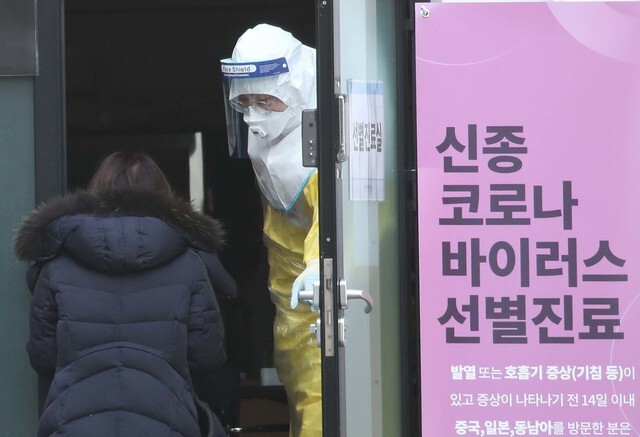hankyoreh
Links to other country sites 다른 나라 사이트 링크
S. Korea to divide roles for different health institutions amid coronavirus outbreak

In preparation for large-scale local transmission of the novel coronavirus, South Korea’s public health authorities have decided to divide the responsibilities of public health centers and public and private hospitals according to symptoms exhibited by patients. In the event of a major increase in the number of cases, there could be a shortage of hospital beds and medical personnel capable of treating those who are severely ill, and the authorities hope to have a system in place to prevent that sort of chaos. Thus far, patients with COVID-19, the disease caused by the novel coronavirus, have generally been hospitalized and treated at state-designated medical facilities regardless of the severity of their symptoms.
“Hospital beds will be assigned according to the severity of cases. Diagnosis and treatment of mild cases will be handled by public health centers and public hospitals, while patients facing more complicated or severe cases of the disease will be placed under quarantine at state-designated hospitals and general hospitals. We’re currently discussing who will make those decisions, and on what principles,” said Jung Eun-kyeong, director of the Korea Centers for Disease Control and Prevention (KCDC), during a daily press briefing on Feb. 18.
Jung also urged local governments to prepare quarantine facilities, medical personnel, and means of transporting patients on the scale that would be needed to deal with local cases. There are concerns that local governments might not have taken adequate preparations because the cases confirmed so far have been concentrated in the greater Seoul area.
The KCDC has launched a review of each city and province’s plans for operating hospital beds and medical personnel. “We’re reviewing each local governmental body’s contingency plans for a major outbreak on the community level. The questions we’re asking are which hospitals and sickbeds will be used, what order they’ll be used in, how staff will be assigned and used in treatment, and whether the necessary equipment is on hand,” said Kim Kang-lip, deputy director of the central disease control headquarters.
Currently, there are 29 hospitals around the country that are designated by the government for hospital treatment of COVID-19, with 198 negative pressure quarantine rooms and 337 ordinary quarantine rooms in operation. The medical personnel who have been treating confirmed and suspected patients at those hospitals over the past month have complained of high levels of fatigue.
“Every day, six or seven suspected patients are sent here from the testing centers. I put on protective gear to interview patients and then prepare their charts after testing them, a process that takes two hours for each patient,” said a specialist of infectious diseases who requested anonymity.
“An increase in the current number could disrupt the system of care even if there are enough sickbeds. Possible issues could be a shortage of medical personnel or patients being sent to hospitals where they aren’t likely to receive proper treatment.”
By Park Hyun-jung, staff reporter
Please direct comments or questions to [english@hani.co.kr]

Editorial・opinion
![[Column] Will Seoul’s ties with Moscow really recover on their own? [Column] Will Seoul’s ties with Moscow really recover on their own?](https://flexible.img.hani.co.kr/flexible/normal/500/300/imgdb/original/2024/0513/5917155871573919.jpg) [Column] Will Seoul’s ties with Moscow really recover on their own?
[Column] Will Seoul’s ties with Moscow really recover on their own?![[Column] Samsung’s ‘lost decade’ and Lee Jae-yong’s mismatched chopsticks [Column] Samsung’s ‘lost decade’ and Lee Jae-yong’s mismatched chopsticks](https://flexible.img.hani.co.kr/flexible/normal/500/300/imgdb/original/2024/0512/3017154788490114.jpg) [Column] Samsung’s ‘lost decade’ and Lee Jae-yong’s mismatched chopsticks
[Column] Samsung’s ‘lost decade’ and Lee Jae-yong’s mismatched chopsticks- [Correspondent’s column] The real reason the US is worried about Chinese ‘overcapacity’
- [Editorial] Yoon’s gesture at communication only highlights his reluctance to change
- [Editorial] Perilous stakes of Trump’s rhetoric around US troop pullout from Korea
- [Guest essay] Preventing Korean Peninsula from becoming front line of new cold war
- [Column] The state is back — but is it in business?
- [Column] Life on our Trisolaris
- [Editorial] Penalties for airing allegations against Korea’s first lady endanger free press
- [Editorial] Yoon must halt procurement of SM-3 interceptor missiles
Most viewed articles
- 1Seoul’s plan to adopt SM-3 missiles is like wanting a sledgehammer to catch a fly
- 2[Column] Samsung’s ‘lost decade’ and Lee Jae-yong’s mismatched chopsticks
- 3[Correspondent’s column] The real reason the US is worried about Chinese ‘overcapacity’
- 4Korea poised to overtake Taiwan as world’s No. 2 chip producer by 2032
- 560% of young Koreans see no need to have kids after marriage
- 6[Editorial] Yoon’s gesture at communication only highlights his reluctance to change
- 7Yoon voices ‘trust’ in Japanese counterpart, says alliance with US won’t change
- 8Yoon rejects calls for special counsel probes into Marine’s death, first lady in long-awaited presse
- 9S.K.-Japan joint history project to be revived
- 10Former President Roh Tae-woo, mastermind of 1979 military coup, dies at 88